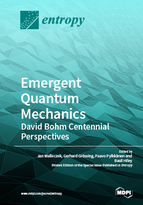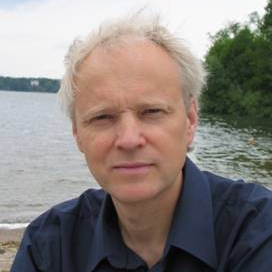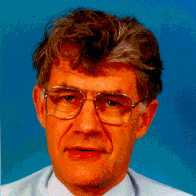Emergent Quantum Mechanics – David Bohm Centennial Perspectives
A special issue of Entropy (ISSN 1099-4300).
Deadline for manuscript submissions: closed (30 April 2018) | Viewed by 192482
Special Issue Editors
Interests: quantum ontology; nonlocal information; effective non-signalling; experimenter free will; quantum complexity; non-equilibrium systems
Interests: analytic quantum modeling; nonlinear sub-quantum dynamics; computer simulations; non-signalling and special relativity
Interests: Bohmian quantum information; quantum ontology and causality; physics of the conscious agent
Interests: foundations of quantum theory and general relativity; algebraic approach to quantum phenomena; orthogonal and symplectic Clifford algebras
Special Issue Information
Dear Colleagues,
Emergent quantum mechanics (EmQM) is a research program that explores the possibility of an ontology for quantum mechanics. The resurgence of interest in realist approaches to quantum mechanics, including deterministic and indeterministic ones, challenges the standard textbook view. For example, standard “no-go” theorems against the possibility of realist, i.e., ontologically-grounded, quantum mechanics are increasingly recognized as falling short of their stated aim. Recent work also indicates that traditional assumptions and theorems such as nonlocality, contextuality, free choice, and non-signalling, need not necessarily contradict the existence of certain quantum ontologies.
On the occasion of David Bohm’s 100th birthday, a symposium on emergent quantum mechanics will be held at the University of London, Senate House, on October 26–28, 2017 (www.emqm17.org). This Special Issue features expert views that critically evaluate the prospects and significance—for 21st century physics—of ontological quantum mechanics, an approach which David Bohm helped pioneer. In original de Broglie-Bohm theory, the mathematical formalism refers to hypothetical ontic elements (e.g., John Bell’s “beables”) such as the quantum potential. In the 21st century, realist quantum approaches often distinguish between ψ-epistemic and ψ-ontic ontological quantum theories. Unlike ψ-ontic theories, the ψ-epistemic theories do not view the wave function ψ as a state of reality. Nevertheless, both types of approaches posit—again—the possibility of an ontological foundation for quantum mechanics.
Twenty-five years ago, David Bohm and Basil Hiley pointed out, in the book “The Undivided Universe”, the close resemblance between key properties of deterministic, hidden-variable, pilot-wave theory and emergence theory, i.e., the theory describing the emergent formation of ordered (i.e., negentropic) states in nonlinear, self-organizing systems, such as deterministic chaos. The notion of ‘emergence’, when applied in the context of an EmQM, often entails two meanings: (1) theory emergence, or (2) physical emergence. Theory emergence describes the idea that the results of orthodox quantum theory might be derived from a more general, deeper-level (sub-)quantum theory. More specifically, the notion of ‘physical emergence’ in quantum systems holds that the orthodox quantum view is neither complete nor fundamental but that an as-yet unknown (sub-) quantum ontology might exist. Consequently, essential questions directing the EmQM research agenda are: Is reality intrinsically random or fundamentally interconnected? Is the universe local or nonlocal? Might a radically new conception of reality include a new form of “quantum causality”?
This Special Issue explores the possibility of an ontology for quantum mechanics. The focus is the search for a "deeper-level" theory for quantum mechanics that interconnects three fields of knowledge: emergence, the quantum, and information. Contributions will be featured that present current advances in realist approaches to quantum mechanics, including new experiments, work in quantum foundations, and the physics of the quantum observer and the conscious experimenter agent.
Topics of the Special Issue:
- Interpretations of Quantum Mechanics
- Nonlocality and Violation of Bell Inequalities
- Quantum Probabilities and Contextuality
- Quantum Causality and Ontology
- Information Measures in Quantum Theory
- Quantum Observation and the Physics of the Experimenter Agent
- Nonlinear Methods applied to Quantum Theory
- Self-organization and Quantum Emergence
- Hidden Variable Theories and Relativity
- Emergent Space-time
Dr. Jan Walleczek
Dr. Gerhard Grössing
Dr. Paavo Pylkkänen
Dr. Basil Hiley
Guest Editors
Manuscript Submission Information
Manuscripts should be submitted online at www.mdpi.com by registering and logging in to this website. Once you are registered, click here to go to the submission form. Manuscripts can be submitted until the deadline. All submissions that pass pre-check are peer-reviewed. Accepted papers will be published continuously in the journal (as soon as accepted) and will be listed together on the special issue website. Research articles, review articles as well as short communications are invited. For planned papers, a title and short abstract (about 100 words) can be sent to the Editorial Office for announcement on this website.
Submitted manuscripts should not have been published previously, nor be under consideration for publication elsewhere (except conference proceedings papers). All manuscripts are thoroughly refereed through a single-blind peer-review process. A guide for authors and other relevant information for submission of manuscripts is available on the Instructions for Authors page. Entropy is an international peer-reviewed open access monthly journal published by MDPI.
Please visit the Instructions for Authors page before submitting a manuscript. The Article Processing Charge (APC) for publication in this open access journal is 2600 CHF (Swiss Francs). Submitted papers should be well formatted and use good English. Authors may use MDPI's English editing service prior to publication or during author revisions.









